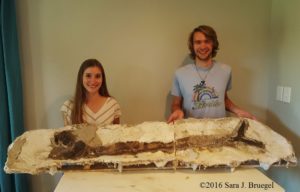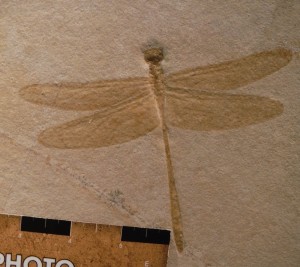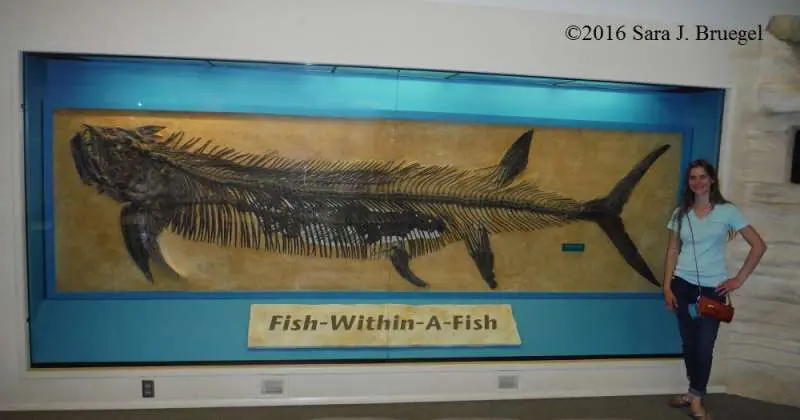My excitement and nervousness rose as the powdery gray dust puffed up from where both my friend and I carefully chipped away at the flaky gray rock, revealing tiny areas of black, little by little. Those little areas of black were not rock, but part of the fossil we were excavating. And they weren’t just any part of that fossil – these little black sections of bone belonged to the skull and gill areas of a large fish fossil. It had been almost a year since we had found this four-foot long fish fossil (read about the original find in Fishy Finds), and here in the final stages of excavation and preparation, uncovering the skull would be essential to properly identify what kind of fish we had. From the skull, tail, and other features, it was determined that this fish fit best under the genus, Gillicus.

There is another very interesting Gillicus fish fossil from the same region of Kansas. Not only was this fish preserved in rock, but it was also preserved inside a larger fish! This Gillicus was about six-and-a-half feet long, but in the belly of a different type of fish that was about thirteen feet long. Together the two make up the famous “Fish-Within-A-Fish” fossil. A display replica of the two can be seen at the Sternberg Museum in Hays, Kansas. According to “Oceans of Kansas” paleontology research website, this “Fish-Within-A-Fish” is probably the most photographed fossil in the world.
Of course, when we see the “Fish-Within-A-Fish” fossil, we tend to think right away that the bigger fish must be eating the Gillicus. Although it’s important to not jump to hasty conclusions about fossils, judging by the other fossils found in the area and other fossils preserved while eating, it seems reasonable to say that the Gillicus probably was being eaten. The larger fish may have “bit off more than it could chew” and died due to the squirming of the smaller Gillicus inside of it. Whether the larger fish died for this reason, or just due to the perils of the global flood, we can tell that they must have been buried very quickly together to be beautifully preserved, like we see them today, without getting picked to pieces by other creatures in the sea. A normal ocean environment like we see today could never preserve fish like these – their burial is much better explained by mud flows from a catastrophic, global food.

Similar fossils have been found in Kansas and other places as well, like the Solnhoffen formation. This rock formation in Germany features tons of different spectacularly preserved fossils, including extremely delicate jellyfish and dragonflies. One of these German fossils is a set of three creatures making a food chain – a pterosaur that just swallowed a small fish, but got dragged into the water and drown by a larger fish. All three were preserved together, and the small fish inside the pterosaurs’ throat looks like it hasn’t been digested yet. This set of violent fossils, like the Kansas “Fish-Within-A-Fish”, must have been buried extremely quickly to be preserved.
Although these creatures are eating one another and dying, they have been beautifully preserved. Death and destruction were not part of God’s original “very good” creation, but a result of sin (evil) coming into the world through Adam and Eve. Yes, there was pain, death, and destruction during the flood and we still have them today. But, take a look at the message we can see through these fossils. We see death and destruction in these fossils, but we also can see spectacular preservation in them. Although sometimes God’s justice will require death and destruction, His mercy can do wonders preserving and making something beautiful out of it, and it was because of His great love that He created them (and us) in the first place.
© Sara J. Bruegel, October 2016
References:
- Robinson,Philip. October 2015.Three become one:Two fish and a pterosaur locked in a fatal struggle. Creation Magazine 37(4):38–39. Last accessed 10-21-16
http://creation.com/two-fish-and-pterosaur-fossilized-together - Everhart, Mike. 2000-2012. Sternberg Museum of Natural History:The Unofficial Virtual Tour. Last updated 06/10/2012. Last accessed 10-21-16
http://oceansofkansas.com/Sternbrg.html





